Selection of Solar Powered Unmanned Aerial Vehicles for a Long Range Data Acquisition Chain
Abstract
:1. Introduction
2. Concept and Method
- (a)
- static protocols—characterized by static routing tables;
- (b)
- proactive protocols—periodically refreshed routing tables;
- (c)
- reactive protocols—path discovered on demand;
- (d)
- hybrid protocols—the combination of proactive and reactive protocols;
- (e)
- position/geographically-based protocols—based on locations or covered areas;
- (f)
- hierarchical protocols—using the hierarchy model for routing.
3. Energy Harvesting and Time of Network Chain Building
4. Flight Range Reduction in a Function of Payload Mass
- Input data: The set of available drones, the set of available solar panels, the length of the network chain, the maximum mass of the payload of a single drone, and the time limit of building the chain.
- Step 1: Find the most efficient solar panel.
- Step 2: Compute the total time of building the network chain for an assumed length D.
- Step 3: If the total time of building the chain exceeds the limit important for a given application, choose a new set of drones or solar panels. If not, go to the next step.
- Step 4: Compute the total time of building the network chain with the same length for all drones carrying a payload with assumed mass.
- Step 5: If the total time of building the chain exceeds the limit important for a given application, reduce the mass of the payload. Alternatively, we can change the set of drones or solar panels. If the computed time is less than the assumed limit, go to the next step.
- Step 6: Compute the total cost of building the network chain for drones that guarantees the total time of building the chain less than the assumed limit.
- Step 7: From models of drones considered in Step 6, choose a model that satisfies your technical and financial requirements.
5. Conclusions
- It is possible to build a network chain with a length significantly exceeding the range of any single drone in a time interval that can be considered acceptable for many applications.
- Drones can be cheap and small.
- Drones can operate in non-urbanized areas without electricity access or communication infrastructure.
- The payload mass can influence the rank of the most effective drones.
- It is impossible to choose the best models of drones studying only the values of parameters provided by manufacturers. It can result in non-optimal technical and financial decisions, which may be critical for many drone applications, e.g., during military conflicts.
Author Contributions
Funding
Institutional Review Board Statement
Informed Consent Statement
Data Availability Statement
Conflicts of Interest
References
- Kilby, T.; Kilby, B. Getting Started with Drones; APN Promise: Warsaw, Poland, 2016. [Google Scholar]
- Becerra, V.M. Autonomous Control of Unmanned Aerial Vehicles. Electronics 2019, 8, 452. [Google Scholar] [CrossRef] [Green Version]
- Amorosi, L.; Chiaraviglio, L.; Galán-Jiménez, J. Optimal Energy Management of UAV-Based Cellular Networks Powered by Solar Panels and Batteries: Formulation and Solutions. IEEE Access 2019, 7, 53698–53717. [Google Scholar] [CrossRef]
- Dougherty, M.J. Drones: An Illustrated Guide to the Unmanned Aircraft that Are Filling Our Skies; Amber Books Ltd.: London, UK, 2016. [Google Scholar]
- Prisacariu, V. The History and the Evolution of UAVs from the Beginning till the 70s. J. Def. Resour. Manag. 2017, 8, 181–189. [Google Scholar]
- Glassock, R.; Hung, J.; Gonzalez, L.; Walker, R. Multimodal hybrid powerplant for unmanned aerial systems (UAS) robotics. In Proceedings of the Twenty-Fourth Bristol International Unmanned Air Vehicle Systems Conference, Bristol, UK, 30 March–1 April 2009; University of Bristol: Bristol, UK, 2009; pp. 1–13. [Google Scholar]
- Korchenko, G.; Illyash, O.S. The generalized classification of Unmanned Air Vehicles. In Proceedings of the 2013 IEEE 2nd International Conference Actual Problems of Unmanned Air Vehicles Developments Proceedings (APUAVD), Kiev, Ukraine, 15–17 October 2013; pp. 28–34. [Google Scholar] [CrossRef]
- Guizani, S. Low Energy System Proposal for UAV Applications Using Flexible Solar Cells. In Proceedings of the 2019 15th International Wireless Communications & Mobile Computing Conference (IWCMC), Tangier, Morocco, 24–28 June 2019; pp. 455–458. [Google Scholar] [CrossRef]
- Hayajneh, M.; Zaidi, S.A.R.; McLernon, D.C.; Ghogho, M. Drone Empowered Small Cellular Disaster Recovery Networks for Resilient Smart Cities. In Proceedings of the 2016 IEEE International Conference on Sensing, Communication and Networking (SECON Workshops), London, UK, 27 June 2016; pp. 1–6. [Google Scholar] [CrossRef] [Green Version]
- Prasad, S.; Ulaganathan, M.; Durairaj, D.; Aljaafreh, M.J.; AlSalhi, M. Implementation of MPPT for Flexible Solar Cells embedded on Unmanned Aerial Vehicles. In Proceedings of the 2019 IEEE International Conference on Intelligent Techniques in Control, Optimization and Signal Processing (INCOS), Tamilnadu, India, 11–13 April 2019; pp. 1–6. [Google Scholar] [CrossRef]
- Celik, K.; Eren, H. UAV fuel preferences for future cities. In Proceedings of the 2018 6th International Istanbul Smart Grids and Cities Congress and Fair (ICSG), Istanbul, Turkey, 25–26 April 2018; pp. 151–154. [Google Scholar] [CrossRef]
- In-Flight Wireless Charging; Global Energy Transmission. Available online: http://getcorp.com/technology-overview/#tab-542 (accessed on 1 September 2020).
- Ali, A.; Hasna, M.O. Energy Harvesting Schemes for UAV based Communications. In Proceedings of the 2019 16th IEEE Annual Consumer Communications & Networking Conference (CCNC), Las Vegas, NV, USA, 11–14 January 2019; pp. 1–2. [Google Scholar] [CrossRef]
- H3 Dynamics. Available online: https://www.h3dynamics.com (accessed on 1 September 2020).
- Ji, B.; Li, Y.; Zhou, B.; Li, C.; Song, K.; Wen, H. Performance Analysis of UAV Relay Assisted IoT Communication Network Enhanced with Energy Harvesting. IEEE Access 2019, 7, 38738–38747. [Google Scholar] [CrossRef]
- Thipyopas, C.; Sripawadkul, V.; Warin, N. Design and Development of a Small Solar-Powered UAV for Environmental Monitoring Application. In Proceedings of the 2019 IEEE Eurasia Conference on IOT, Communication and Engineering (ECICE), Yunlin, Taiwan, 3–6 October 2019; pp. 316–319. [Google Scholar] [CrossRef]
- Hamza, A.; Mohammed, A.; Isah, A. Towards Solar-Powered Unmanned Aerial Vehicles for Improved Flight Performance. In Proceedings of the 2019 2nd International Conference of the IEEE Nigeria Computer Chapter (NigeriaComputConf), Zaria, Nigeria, 14–17 October 2019; pp. 1–5. [Google Scholar] [CrossRef]
- Chen, H.; Khaligh, A. Hybrid energy storage system for unmanned aerial vehicle (UAV). In Proceedings of the IECON 2010—36th Annual Conference on IEEE Industrial Electronics Society, Glendale, AZ, USA, 7–10 November 2010; pp. 2851–2856. [Google Scholar] [CrossRef]
- Matuszewski, Ł.; Woźniak, W.; Stołowski, P.; Jessa, M. Measurement data acquisition system with mobile server. Meas. Autom. Monit. 2017, 63, 174–176. [Google Scholar]
- Chiaraviglio, L.; d’Andreagiovanni, F.; Liu, W.; Gutierrez, J.; Blefari-Melazzi, N.; Choo, K.K.R.; Alouini, M.S. Multi-Area Throughput and Energy Optimization of UAV-aided Cellular Networks Powered by Solar Panels and Grid. IEEE Trans. Mob. Comput. 2020, 19, 1–18. [Google Scholar] [CrossRef]
- Erdelj, M.; Natalizio, E.; Chowdhury, K.R.; Akyildiz, I.F. Help from the Sky: Leveraging UAVs for Disaster Management. IEEE Pervasive Comput. 2017, 16, 24–32. [Google Scholar] [CrossRef]
- Zhou, Z.; Zhang, C.; Xu, C.; Xiong, F.; Zhang, Y.; Umer, T. Energy-Efficient Industrial Internet of UAVs for Power Line Inspection in Smart Grid. IEEE Trans. Ind. Inform. 2018, 14, 2705–2714. [Google Scholar] [CrossRef] [Green Version]
- Khan, M.A.; Safi, A.; Qureshi, I.M.; Khan, I.U. Flying ad-hoc networks (FANETs): A review of communication architectures, and routing protocols. In Proceedings of the 2017 First International Conference on Latest trends in Electrical Engineering and Computing Technologies (INTELLECT), Karachi, Pakistan, 15–16 November 2017; pp. 1–9. [Google Scholar] [CrossRef]
- Tareque, M.H.; Hossain, M.S.; Atiquzzaman, M. On the Routing in Flying Ad hoc Networks. In Proceedings of the 2015 Federated Conference on Computer Science and Information Systems (FedCSIS), Lodz, Poland, 13–16 September 2015; pp. 1–9. [Google Scholar] [CrossRef] [Green Version]
- Yang, Z.; Xu, W.; Shikh-Bahaei, M. Energy Efficient UAV Communication with Energy Harvesting. IEEE Trans. Veh. Technol. 2020, 69, 1913–1927. [Google Scholar] [CrossRef] [Green Version]
- Tan, Z.; Qu, H.; Ren, G.; Wang, W. UAV-aided Sustainable Communication in Cellular IoT System with Hybrid Energy Harvesting. In Proceedings of the 2019 4th International Conference on Smart and Sustainable Technologies (SpliTech), Split, Croatia, 18–21 June 2019; pp. 1–6. [Google Scholar] [CrossRef]
- Chen, Y.; Baek, D.; Bocca, A.; Macii, A.; Macii, E.; Poncino, M. A Case for a Battery-Aware Model of Drone Energy Consumption. In Proceedings of the 2018 IEEE International Telecommunications Energy Conference (INTELEC), Torino, Italy, 7–11 October 2018; pp. 1–8. [Google Scholar] [CrossRef]
- D’Andrea, R. Guest Editorial Can Drones Deliver? IEEE Trans. Autom. Sci. Eng. 2014, 11, 647–648. [Google Scholar] [CrossRef]
- Choi, Y.; Schonfeld, P.M. Drone Deliveries Optimization with Battery Energy Constraints. In Proceedings of the Transportation Research Board 97th Annual Meeting, Washington, DC, USA, 7–11 January 2018. [Google Scholar]
- Dorling, K.; Heinrichs, J.; Messier, G.G.; Magierowski, S. Vehicle Routing Problems for Drone Delivery. IEEE Trans. Syst. Man Cybern. Syst. 2017, 47, 70–85. [Google Scholar] [CrossRef] [Green Version]
- Sarkar, S.; Totaro, M.W.; Kumar, A. An Intelligent Framework for Prediction of a UAV’s Flight Time. In Proceedings of the 2020 16th International Conference on Distributed Computing in Sensor Systems (DCOSS), Marina del Rey, CA, USA, 25–27 May 2020; pp. 328–332. [Google Scholar] [CrossRef]
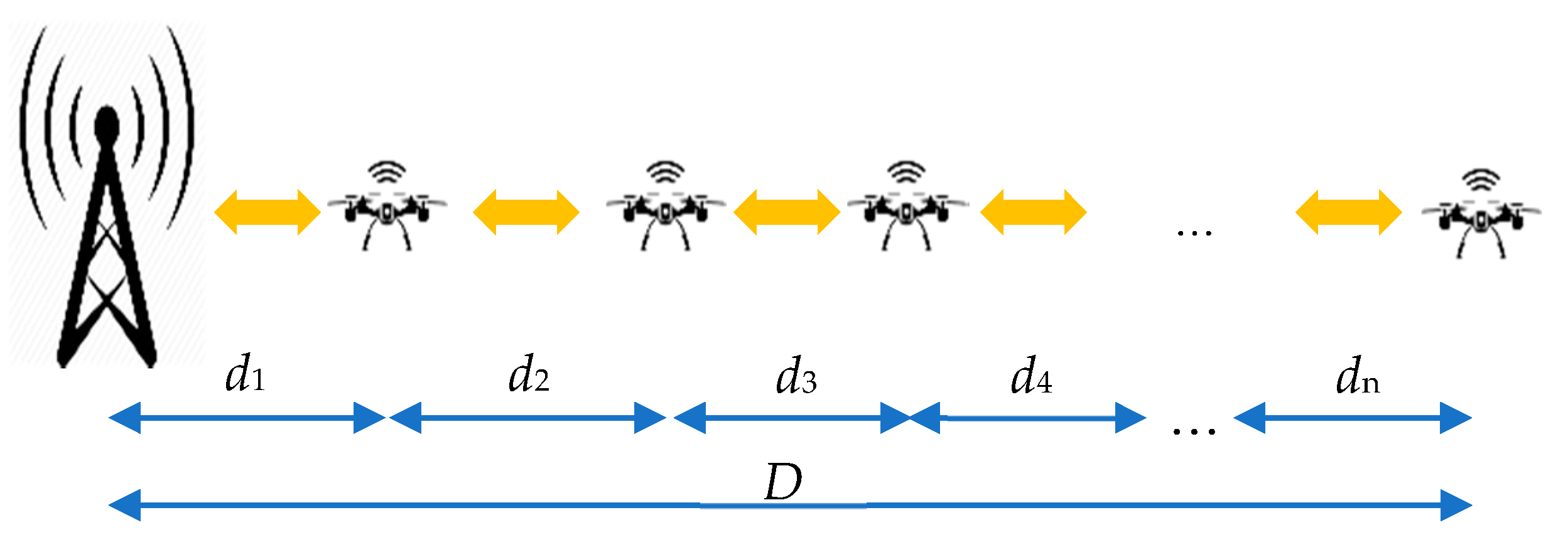
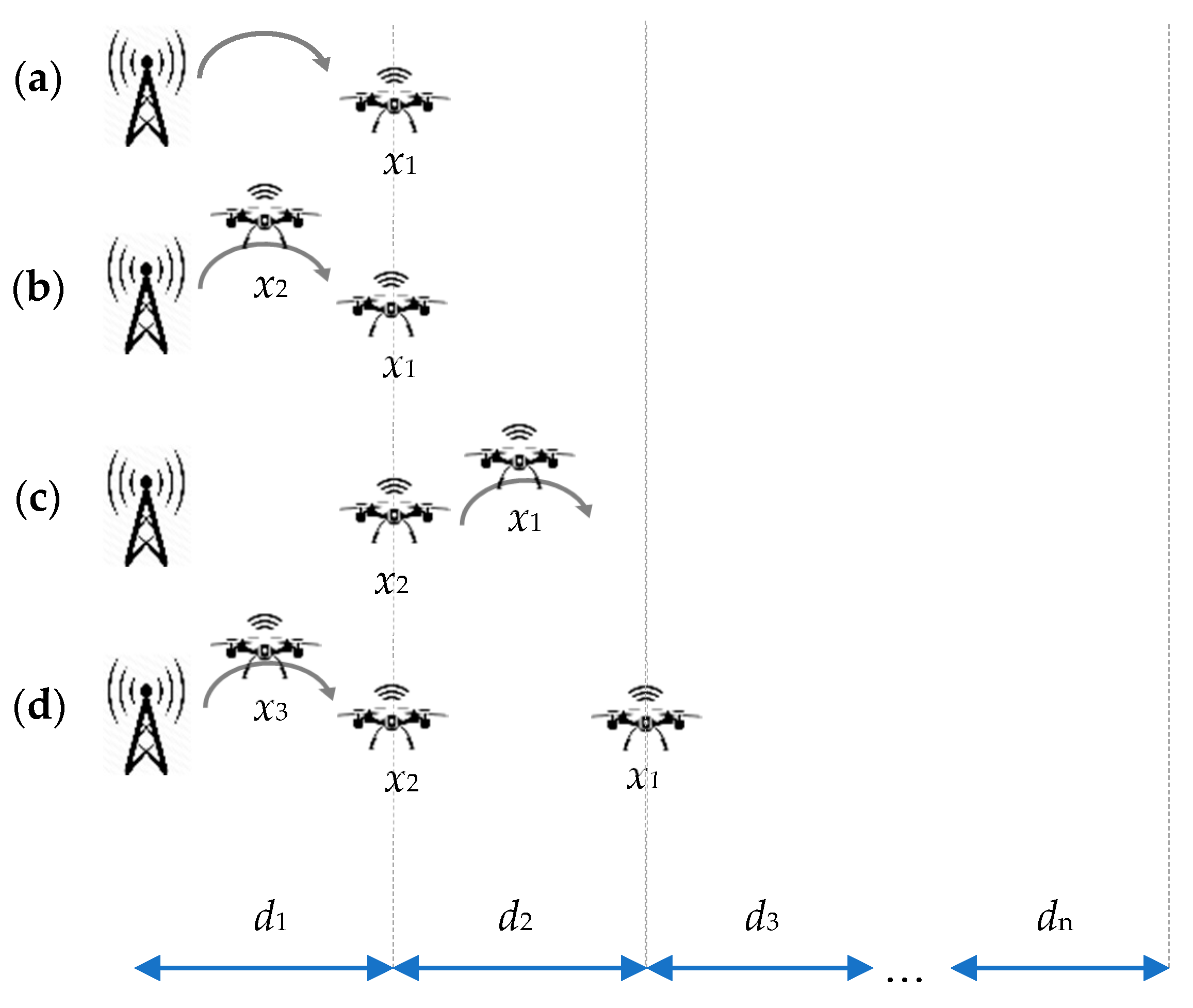
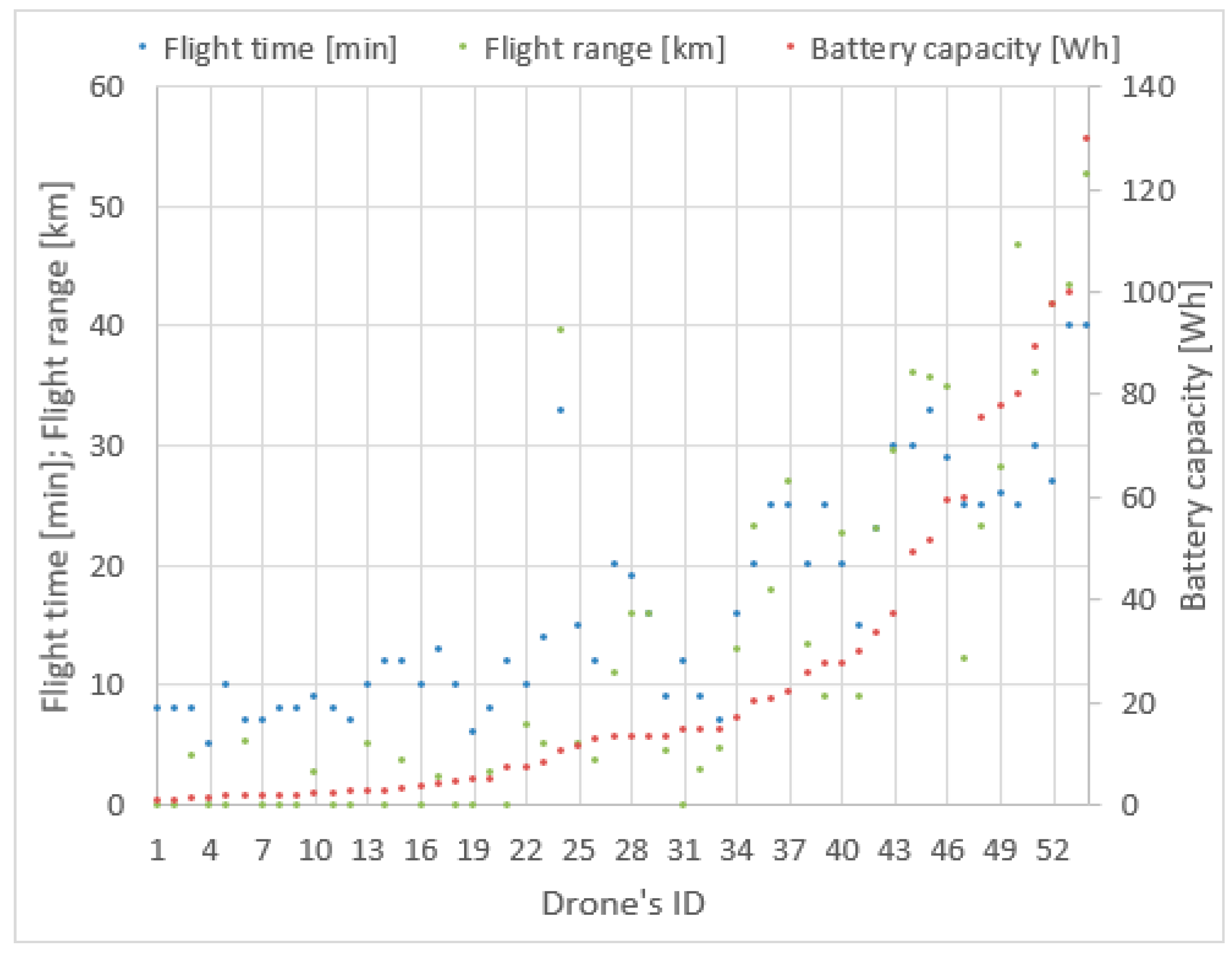
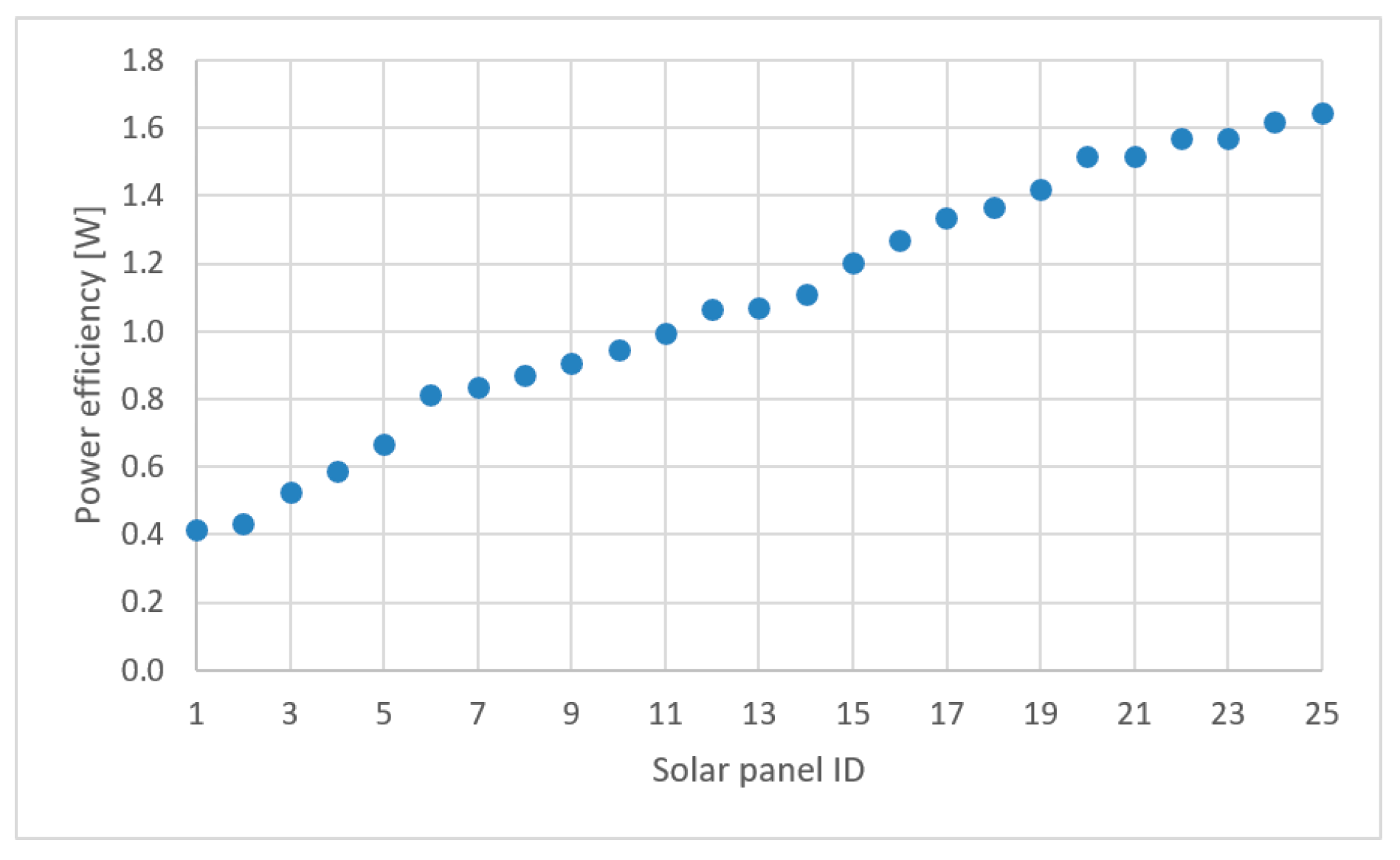



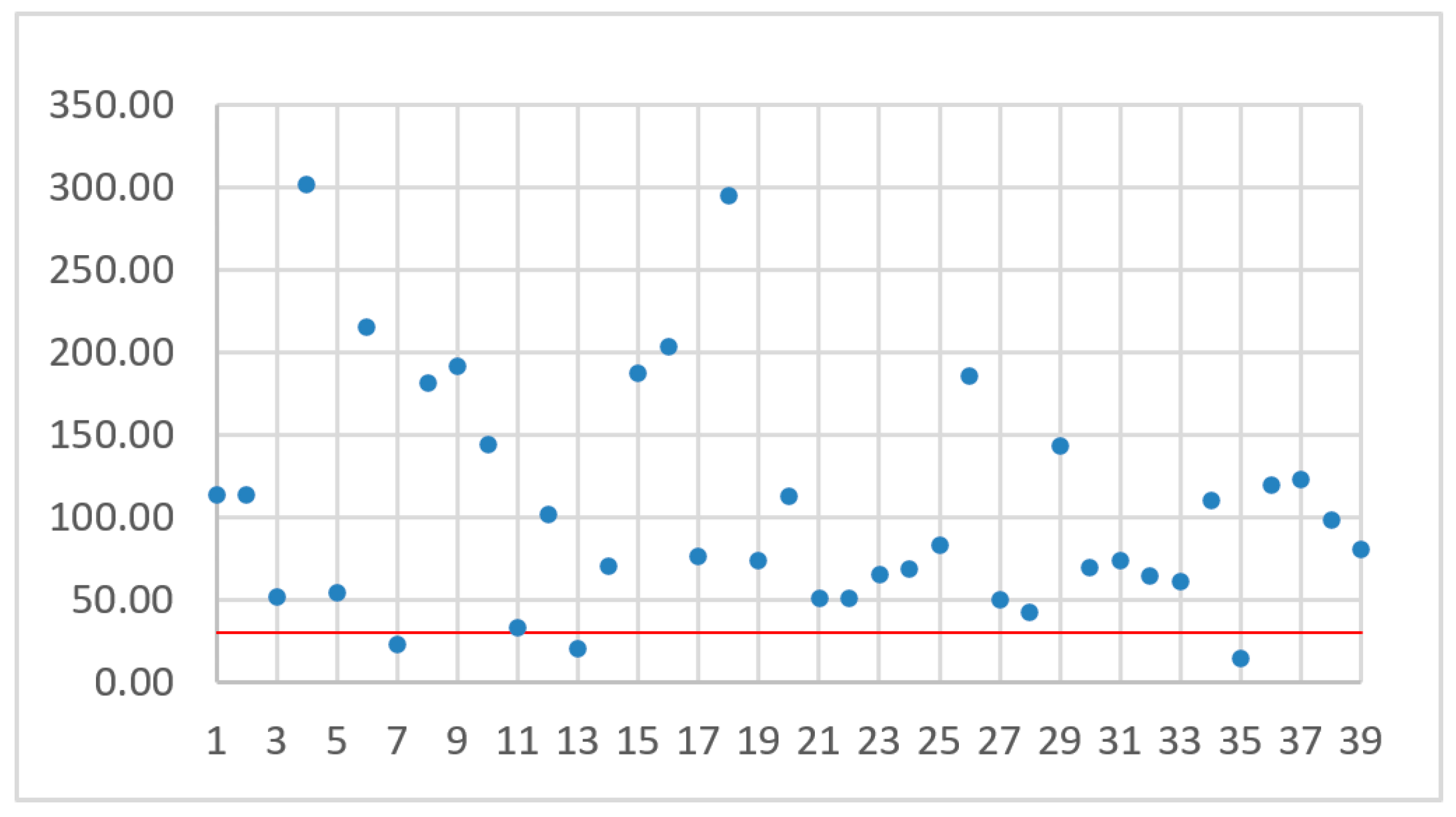


| ID | Vendor | Battery Capacity [mAh] | Battery Voltage [V] | Max. Flight Time [min] | Max. Flight Speed [km/h] | Max. Flight Range [km] | ID | Vendor | Battery Capacity [mAh] | Battery Voltage [V] | Max. Flight Time [min] | Max. Flight Speed [km/h] | Max. Flight Range [km] |
|---|---|---|---|---|---|---|---|---|---|---|---|---|---|
| 1 | Syma X20W | 180 | 3.70 | 8 | - | - | 28 | Overmax X-Bee Drone 8.0 | 1800 | 7.40 | 19 | 50 | 15.83 |
| 2 | Syma X11C | 200 | 3.70 | 8 | - | - | 29 | JJRC X5 | 1800 | 7.40 | 16 | 60 | 16.00 |
| 3 | Overmax OV-X-Bee Drone 2.4 | 350 | 3.70 | 8 | 30 | 4.00 | 30 | Overmax X-Bee Drone 5.5 | 1800 | 7.40 | 9 | 30 | 4.50 |
| 4 | Syma X21W | 380 | 3.70 | 5 | - | - | 31 | Overmax X-Bee Drone 7.2 | 2000 | 7.40 | 12 | - | - |
| 5 | JJRC H31 | 400 | 3.70 | 10 | - | - | 32 | Syma X8 PRO | 2000 | 7.40 | 9 | 20 | 3.00 |
| 6 | Hubsan X4 H107D | 380 | 4.00 | 7 | 45 | 5.25 | 33 | Syma X8HW | 2000 | 7.40 | 7 | 40 | 4.67 |
| 7 | Syma X15W | 450 | 3.70 | 7 | - | - | 34 | DJI Spark | 1480 | 11.40 | 16 | 49 | 13.07 |
| 8 | Syma X5SW Explorers 2 | 500 | 3.70 | 8 | - | - | 35 | Hubsan H501A | 2700 | 7.40 | 20 | 70 | 23.33 |
| 9 | Syma X23W | 500 | 3.70 | 8 | - | - | 36 | Parrot Anafi | 2700 | 7.60 | 25 | 43 | 17.92 |
| 10 | Parrot Mambo fly | 550 | 3.70 | 9 | 18 | 2.70 | 37 | XIAOMI FIMI A3 | 2000 | 11.10 | 25 | 65 | 27.08 |
| 11 | Syma X5HW | 600 | 3.70 | 8 | - | - | 38 | JJRC X11 | 3400 | 7.60 | 20 | 40 | 13.33 |
| 12 | Syma X54HW | 650 | 3.70 | 7 | - | - | 39 | JJRC X12 | 2400 | 11.40 | 25 | 21.6 | 9.00 |
| 13 | Parrot Mambo Mission | 660 | 3.70 | 10 | 30 | 5.00 | 40 | DJI Mavic Air | 2375 | 11.55 | 20 | 68 | 22.67 |
| 14 | Overmax X-Bee Drone 3.1 | 750 | 3.70 | 12 | - | - | 41 | Cheerson CX-20 | 2700 | 11.10 | 15 | 36 | 9.00 |
| 15 | uGo Sirocco | 800 | 3.70 | 12 | 18 | 3.60 | 42 | Hubsan H117S Zino | 3000 | 11.10 | 23 | 60 | 23.00 |
| 16 | XIAOMI MI DRONE MINI | 920 | 3.80 | 10 | - | - | 43 | Parrot BEBOP 2 POWER | 3350 | 11.10 | 30 | 59 | 29.50 |
| 17 | DJI Ryze Tello | 1100 | 3.80 | 13 | 11 | 2.38 | 44 | Autel EVO | 4300 | 11.40 | 30 | 72 | 36.00 |
| 18 | Overmax X-Bee Drone 6.1 | 600 | 7.40 | 10 | - | - | 45 | XIAOMI FIMI X8 SE | 4500 | 11.40 | 33 | 65 | 35.75 |
| 19 | Xblitz DISCOVER | 650 | 7.40 | 6 | - | - | 46 | DJI Mavic 2 Pro | 3850 | 15.40 | 29 | 72 | 34.80 |
| 20 | TKKJ TK116W | 1300 | 3.70 | 8 | 20 | 2.67 | 47 | Yuneec Typhoon Q500 | 5400 | 11.10 | 25 | 29 | 12.08 |
| 21 | Syma X25 PRO | 1000 | 7.40 | 12 | - | - | 48 | GoPro Karma | 5100 | 14.80 | 25 | 56 | 23.33 |
| 22 | Goclever Drone Predator FPV | 2000 | 3.70 | 10 | 40 | 6.67 | 49 | XIAOMI Mi Drone 4K | 5100 | 15.20 | 26 | 65 | 28.17 |
| 23 | JJRC H73 | 1100 | 7.60 | 14 | 22 | 5.13 | 50 | Yuneec Typhoon H | 5400 | 14.80 | 25 | 112 | 46.67 |
| 24 | Yuneec Mantis Q | 2800 | 3.70 | 33 | 72 | 39.60 | 51 | DJI Phantom 4 Pro | 5870 | 15.20 | 30 | 72 | 36.00 |
| 25 | JJRC X9 | 1000 | 11.40 | 15 | 20 | 5.00 | 52 | DJI Inspire 2 | 4280 | 22.80 | 27 | 93 | 41.85 |
| 26 | Yuneec Breeze | 1150 | 11.10 | 12 | 18 | 3.60 | 53 | DJI Matrice 600 | 4500 | 22.20 | 40 | 65 | 43.33 |
| 27 | Overmax X-Bee Drone 9.0 GPS | 1800 | 7.40 | 20 | 33 | 11.00 | 54 | DJI Matrice 100 | 5700 | 22.80 | 40 | 79 | 52.67 |
| Index | Dimensions [mm] | Power Efficiency [W/100 cm2] | Index | Dimensions [mm] | Power Efficiency [W/100 cm2] |
|---|---|---|---|---|---|
| 1 | 120 × 60 × 0.8 | 0.42 | 14 | 95 × 95 | 1.11 |
| 2 | 154 × 45 | 0.43 | 15 | 50 × 50 | 1.2 |
| 3 | 53 × 18 × 2.5 | 0.52 | 16 | 125 × 63 | 1.27 |
| 4 | 112 × 91 × 3 | 0.59 | 17 | 255 × 147 × 2 | 1.33 |
| 5 | 136 × 110 × 3 | 0.67 | 18 | 80 × 55 | 1.36 |
| 6 | 255 × 145 × 9 | 0.81 | 19 | 65 × 65 | 1.42 |
| 7 | 60 × 60 | 0.83 | 20 | 110 × 60 × 2.5 | 1.52 |
| 8 | 20 × 23 | 0.87 | 21 | 120 × 110 × 2 | 1.52 |
| 9 | 115 × 115 × 3 | 0.91 | 22 | 165 × 135 × 3 | 1.57 |
| 10 | 53 × 30 | 0.94 | 23 | 165 × 135 × 3 | 1.57 |
| 11 | 65 × 65 × 3 | 0.99 | 24 | 52 × 19 | 1.62 |
| 12 | 30 × 25 | 1.07 | 25 | 39 × 39 | 1.64 |
| 13 | 100 × 28 | 1.07 |
| Drone | Max. Flight Time [min] | Battery Capacity CbUb [Wh] | Max. Flight Range [km] | Max. Flight Speed [km/h] | No. by TJT | No. by Flight Time | No. by Batt. Capacity | No. by Flight Range | No by Max Flight Speed | Total Journey Time [h] |
|---|---|---|---|---|---|---|---|---|---|---|
| Yuneec Mantis Q | 33.00 | 10.36 | 39.60 | 72.00 | 1 | 36 | 10 | 35 | 36 | 13.99 |
| Hubsan X4 H107D | 7.00 | 1.52 | 5.25 | 45.00 | 2 | 1 | 2 | 13 | 20 | 19.79 |
| Overmax OV-X-Bee Drone 2.4 | 8.00 | 1.30 | 4.00 | 30.00 | 3 | 3 | 1 | 7 | 11 | 23.03 |
| Parrot Mambo Mission | 10.00 | 2.44 | 5.00 | 30.00 | 4 | 8 | 4 | 11 | 13 | 33.05 |
| XIAOMI FIMI A3 | 25.00 | 22.20 | 27.08 | 65.00 | 5 | 25 | 22 | 28 | 27 | 42.06 |
| Hubsan H501A | 20.00 | 19.98 | 23.33 | 70.00 | 6 | 20 | 20 | 27 | 32 | 50.05 |
| JJRC X5 | 16.00 | 13.32 | 16.00 | 60.00 | 7 | 16 | 14 | 22 | 25 | 50.29 |
| Overmax X-Bee Drone 8.0 | 19.00 | 13.32 | 15.83 | 50.00 | 8 | 18 | 15 | 21 | 22 | 50.62 |
| Parrot Mambo fly | 9.00 | 2.04 | 2.70 | 18.00 | 9 | 5 | 3 | 3 | 2 | 51.37 |
| uGo Sirocco | 12.00 | 2.96 | 3.60 | 18.00 | 10 | 10 | 5 | 5 | 3 | 54.18 |
| Autel EVO | 30.00 | 49.02 | 36.00 | 72.00 | 11 | 34 | 29 | 33 | 34 | 61.04 |
| XIAOMI FIMI X8 SE | 33.00 | 51.30 | 35.75 | 65.00 | 12 | 37 | 30 | 32 | 29 | 63.96 |
| Parrot Anafi | 25.00 | 20.52 | 17.92 | 43.00 | 13 | 24 | 21 | 23 | 19 | 64.75 |
| DJI Mavic Air | 20.00 | 27.43 | 22.67 | 68.00 | 14 | 22 | 25 | 24 | 31 | 68.23 |
| Parrot BEBOP 2 POWER | 30.00 | 37.19 | 29.50 | 59.00 | 15 | 33 | 28 | 30 | 24 | 69.56 |
| Goclever Drone Predator FPV PRO | 10.00 | 7.40 | 6.67 | 40.00 | 16 | 9 | 8 | 14 | 17 | 70.03 |
| DJI Mavic 2 Pro | 29.00 | 59.29 | 34.80 | 72.00 | 17 | 32 | 31 | 31 | 33 | 73.53 |
| DJI Spark | 16.00 | 16.87 | 13.07 | 49.00 | 18 | 17 | 19 | 19 | 21 | 73.90 |
| Overmax X-Bee Drone 9.0 GPS | 20.00 | 13.32 | 11.00 | 33.00 | 19 | 19 | 16 | 17 | 14 | 75.97 |
| DJI Matrice 100 | 40.00 | 129.96 | 52.67 | 79.00 | 20 | 39 | 39 | 39 | 37 | 80.33 |
| Hubsan H117S Zino | 23.00 | 33.30 | 23.00 | 60.00 | 21 | 23 | 27 | 25 | 26 | 82.71 |
| Yuneec Typhoon H | 25.00 | 79.92 | 46.67 | 112.00 | 22 | 29 | 35 | 38 | 39 | 98.14 |
| JJRC H73 | 14.00 | 8.36 | 5.13 | 22.00 | 23 | 13 | 9 | 12 | 9 | 101.18 |
| DJI Phantom 4 Pro | 30.00 | 89.22 | 36.00 | 72.00 | 24 | 35 | 36 | 34 | 35 | 109.96 |
| JJRC X11 | 20.00 | 25.84 | 13.33 | 40.00 | 25 | 21 | 23 | 20 | 18 | 112.55 |
| TKKJ TK116W | 8.00 | 4.81 | 2.67 | 20.00 | 26 | 4 | 7 | 2 | 5 | 113.28 |
| DJI Ryze Tello | 13.00 | 4.18 | 2.38 | 11.00 | 27 | 12 | 6 | 1 | 1 | 113.36 |
| DJI Inspire 2 | 27.00 | 97.58 | 41.85 | 93.00 | 28 | 31 | 37 | 36 | 38 | 119.82 |
| DJI Matrice 600 | 40.00 | 99.90 | 43.33 | 65.00 | 29 | 38 | 38 | 37 | 30 | 123.10 |
| XIAOMI Mi Drone 4K | 26.00 | 77.52 | 28.17 | 65.00 | 30 | 30 | 34 | 29 | 28 | 143.03 |
| JJRC X9 | 15.00 | 11.40 | 5.00 | 20.00 | 31 | 14 | 11 | 10 | 7 | 143.72 |
| Overmax X-Bee Drone 5.5 | 9.00 | 13.32 | 4.50 | 30.00 | 32 | 6 | 13 | 8 | 12 | 181.62 |
| GoPro Karma | 25.00 | 75.48 | 23.33 | 56.00 | 33 | 28 | 33 | 26 | 23 | 185.47 |
| JJRC X12 | 25.00 | 27.36 | 9.00 | 21.60 | 34 | 26 | 24 | 15 | 8 | 187.73 |
| Syma X8HW | 7.00 | 14.80 | 4.67 | 40.00 | 35 | 2 | 17 | 9 | 16 | 191.59 |
| Cheerson CX-20 | 15.00 | 29.97 | 9.00 | 36.00 | 36 | 15 | 26 | 16 | 15 | 203.35 |
| Yuneec Breeze | 12.00 | 12.77 | 3.60 | 18.00 | 37 | 11 | 12 | 6 | 4 | 215.24 |
| Yuneec Typhoon Q500 | 25.00 | 59.94 | 12.08 | 29.00 | 38 | 27 | 32 | 18 | 10 | 295.19 |
| Syma X8 PRO | 9.00 | 14.80 | 3.00 | 20.00 | 39 | 7 | 18 | 4 | 6 | 302.14 |
| Rank | Model | Total Journey Time [h] | Max. Flight Time [min] | Battery Capacity [Wh] | Max. Flight Range [km] | Max. Flight Speed [km/h] | Weight [kg] |
|---|---|---|---|---|---|---|---|
| 1 | Yuneec Mantis Q | 13.99 | 33.00 | 10.36 | 39.60 | 72.00 | 0.480 |
| 2 | Hubsan X4 H107D | 19.79 | 7.00 | 1.52 | 5.25 | 45.00 | 0.035 |
| 3 | Overmax OV-X-Bee Drone 2.4 | 23.03 | 8.00 | 1.30 | 4.00 | 30.00 | 0.100 |
| Rank | Model | Total Journey Time [h] | Max. Flight Time [min] | Battery Capacity [Wh] | Max. Flight Range [km] | Max. Flight Speed [km/h] | Weight [kg] |
|---|---|---|---|---|---|---|---|
| 39 | Syma X8 PRO | 302.14 | 9.00 | 14.80 | 3.00 | 20.00 | 0.760 |
| 38 | Yuneec Typhoon Q500 | 295.19 | 25.00 | 59.94 | 12.08 | 29.00 | 1.700 |
| 37 | Yuneec Breeze | 215.24 | 12.00 | 12.77 | 3.60 | 18.00 | 0.385 |
| Rank | Model | Total Journey Time [h] | Max. Flight Time [min] | Battery Capacity [Wh] | Max. Flight Range [km] | Max. Flight Speed [km/h] | Weight [kg] |
|---|---|---|---|---|---|---|---|
| 1 | Yuneec Mantis Q | 20.88 | 23.00 | 10.36 | 27.95 | 72.00 | 0.680 |
| 2 | Hubsan H501A | 62.78 | 14.00 | 19.98 | 16.67 | 45.00 | 0.700 |
| 3 | Overmax X-Bee Drone 8.0 | 67.60 | 14.00 | 13.32 | 11.44 | 30.00 | 0.720 |
| Rank | Model | Total Journey Time [h] | Max. Flight Time [min] | Battery Capacity [Wh] | Max. Flight Range [km] | Max. Flight Speed [km/h] | Weight [kg] |
|---|---|---|---|---|---|---|---|
| 39 | DJI Ryze Tello | 403.11 | 4.00 | 14.80 | 0.68 | 11.00 | 0.280 |
| 38 | Syma X8 PRO | 384.50 | 7.00 | 59.94 | 2.38 | 20.00 | 0.960 |
| 37 | Yuneec Breeze | 334.62 | 8.00 | 12.77 | 2.37 | 18.00 | 0.585 |
| Rank | Model | n | c0 [$] | c [$] |
|---|---|---|---|---|
| 1 | Yuneec Mantis Q | 3 | ≈600 | 1800 |
| 2 | Overmax OV-X-Bee Drone 2.4 | 25 | ≈150 | 3700 |
| 3 | Hubsan X4 H107D | 20 | ≈250 | 5000 |
| Rank | Model | np | c0 [$] | cp [$] |
|---|---|---|---|---|
| 1 | Yuneec Mantis Q | 4 | ≈600 | 2400 |
| 2 | Hubsan H501A | 6 | ≈400 | 2400 |
| 3 | Overmax X-Bee Drone 8.0 | 9 | ≈300 | 2700 |
Publisher’s Note: MDPI stays neutral with regard to jurisdictional claims in published maps and institutional affiliations. |
© 2021 by the authors. Licensee MDPI, Basel, Switzerland. This article is an open access article distributed under the terms and conditions of the Creative Commons Attribution (CC BY) license (https://creativecommons.org/licenses/by/4.0/).
Share and Cite
Woźniak, W.; Jessa, M. Selection of Solar Powered Unmanned Aerial Vehicles for a Long Range Data Acquisition Chain. Sensors 2021, 21, 2772. https://doi.org/10.3390/s21082772
Woźniak W, Jessa M. Selection of Solar Powered Unmanned Aerial Vehicles for a Long Range Data Acquisition Chain. Sensors. 2021; 21(8):2772. https://doi.org/10.3390/s21082772
Chicago/Turabian StyleWoźniak, Wiktor, and Mieczysław Jessa. 2021. "Selection of Solar Powered Unmanned Aerial Vehicles for a Long Range Data Acquisition Chain" Sensors 21, no. 8: 2772. https://doi.org/10.3390/s21082772
APA StyleWoźniak, W., & Jessa, M. (2021). Selection of Solar Powered Unmanned Aerial Vehicles for a Long Range Data Acquisition Chain. Sensors, 21(8), 2772. https://doi.org/10.3390/s21082772





